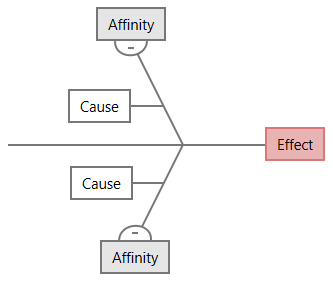Use a fishbone to identify potential causes of an effect. A fishbone
is also called a cause-and-effect (C&E) diagram or
an
Ishikawa diagram.
On a fishbone, the effect, or central problem, is on the far right.
Affinities, which are categories of causes, branch from the spine of the
effect. Causes branch from the affinities. By default, affinities and causes
are expanded so that you can view all levels of the fishbone.


A
Fishbone
answers the following questions.
- What are the potential causes for a particular type of defect?
- What are the process inputs that contribute to variation in the process output?
How-to
- Gather the project team and appropriate stakeholders for a brainstorming session.
- Determine the affinities for the causes of the problem. For example, personnel, machines, methods, materials, measurements, and environment are common affinities.
- For each category, list all possible causes or process inputs. You can create secondary categories for the primary categories, then list the causes or process inputs under the secondary categories. Fishbone diagrams can include any type of cause you want to investigate.
- Identify the most important causes.
Note
You can quickly brainstorm ideas in the brainstorming list, then drag them to the diagram to create associations between related ideas. For more information, go to Generate a brainstorm list.
